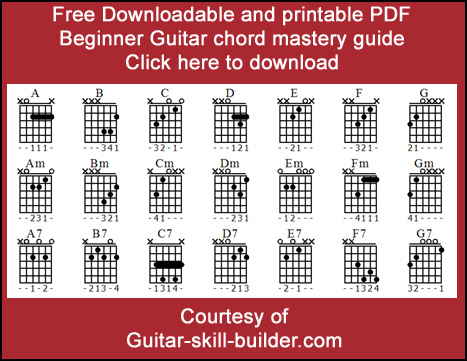Picture this: you’re strumming away on your guitar, feeling like a rock star as you play the same three chords over and over again. But suddenly, you stumble upon a song with a chord progression so complex, it makes your brain hurt just thinking about it. Fear not, fellow guitarists, for we have the ultimate guide to mastering those mind-bending chord progressions. So put down your air guitar and prepare to take your playing to the next level – it’s time to unlock the secrets of complex chords and dazzle your friends with your newfound musical prowess.
Contents
- 1 Understanding the Basics of Complex Chord Progressions
- 2 Exploring Beyond Major and Minor: Diminished, Augmented, and Seventh Chords
- 3 Incorporating Modal Interchanges and Secondary Dominants
- 4 Voice Leading Principles for Smoother Chord Transitions
- 5 Innovative Fingering Techniques for Complex Chord Shapes
- 6 Mastering the Art of Tension and Resolution in Progressions
- 7 Applying Complex Chord Progressions in Various Musical Genres
- 8 FAQs
- 9 In conclusion, remember- mastering complex chord progressions is like solving a Rubik’s cube… but with way more strings involved. So keep practicing, keep experimenting, and most importantly, keep rocking out! And who knows, maybe one day you’ll be the guitar guru everyone turns to for advice on those tricky chord progressions. Happy strumming!
Understanding the Basics of Complex Chord Progressions
Alright, let’s dive into the crazy world of complex chord progressions. Buckle up, because things are about to get a little… well, complex.
First things first, let’s talk about extended chords. These bad boys have more notes in them than your Aunt Sally’s infamous Thanksgiving casserole. We’re talking about chords like the Major 7ths, Minor 7ths, and Dominant 7ths. They may sound intimidating, but once you get the hang of them, you’ll be jamming like a pro.
Next up, let’s chat about modulations. No, we’re not talking about your car’s transmission here. Modulations are when you change keys mid-song, throwing your listeners for a loop. It’s like switching from a rom-com to a horror movie halfway through – unexpected, but oh so thrilling.
And finally, let’s touch on secondary dominants. These sneaky little chords like to pretend they’re leading you one way, only to pull a fast one and go in a completely different direction. They’re like the shapeshifters of the chord world – you never know what they’ll do next.

Exploring Beyond Major and Minor: Diminished, Augmented, and Seventh Chords
So you’re tired of playing the same old major and minor chords, huh? Well, buckle up because we’re about to take you on a wild ride through the world of diminished, augmented, and seventh chords!
First up, we have the diminished chord. This bad boy is like the black sheep of the chord family – dark, mysterious, and oh so edgy. It’s made up of a root note, a minor third, and a diminished fifth. Sounds complicated, right? Well, strap in because things are about to get even crazier.
Next, we have the augmented chord. If the diminished chord is the black sheep, then the augmented chord is the rebel without a cause. It’s made up of a root note, a major third, and an augmented fifth. It’s like a major chord on steroids – bold, brash, and ready to shake things up.
And last but not least, we have seventh chords. These bad boys are like the cool kids in school – laid back, smooth, and always in the groove. They’re made up of a root note, a major third, a perfect fifth, and a minor seventh. They add a whole new level of sophistication to your playing, like a fine wine to a fancy dinner.

Incorporating Modal Interchanges and Secondary Dominants
Modal interchanges and secondary dominants are like the Batman and Robin of chord progressions – they swoop in with their capes flowing and save your music from the clutches of predictability.
With modal interchanges, you can effortlessly move between major and minor modes, adding a touch of intrigue and complexity to your harmonies. It’s like adding a secret ingredient to your musical recipe - suddenly, your bland progression becomes a flavorful feast for the ears.
Secondary dominants, on the other hand, are the smooth-talking charmers of the chord world. They seduce your ears with their unexpected twists and turns, leading you down a musical rabbit hole you never knew existed. Before you know it, you’re hooked and can’t imagine your music without them.
So, next time you’re stuck in a musical rut, don’t be afraid to call upon the dynamic duo of modal interchanges and secondary dominants. Let them swoop in, shake things up, and take your music to new heights. Your listeners will thank you, and you’ll feel like a musical superhero in no time!

Voice Leading Principles for Smoother Chord Transitions
So you want to master those smooth chord transitions, huh? Well, lucky for you, I’ve got some voice leading principles up my sleeve that will make that dream a reality faster than you can say “C major.”
First off, always remember that the key to buttery-smooth chord changes lies in the smooth movement of individual voices. Make sure each note in your chord progression moves into the next chord with as little jarring motion as possible. It’s like a graceful dance party for your fingers!
Next, consider the independence of voice movement. Each note in your chord should have a mind of its own, moving in a different direction than its neighbor. This creates a rich tapestry of sound that will have your listeners swooning in no time.
And hey, don’t forget about voice leading by step. Moving from one chord to the next in small intervals creates a seamless transition that will have your audience wondering if you’ve secretly hired a team of angels to play alongside you. Trust me, it’s that heavenly.

Innovative Fingering Techniques for Complex Chord Shapes
Have you ever found yourself struggling to play those tricky chord shapes that seem to require an extra set of fingers to execute? Fear not, for we have some innovative fingering techniques that will revolutionize the way you approach complex chords!
First up, try utilizing the Spider Technique. This involves positioning your fingers in a spider-like formation, with each finger assigned to a specific string. This technique might feel a bit creepy-crawly at first, but once you get the hang of it, you’ll be weaving intricate chord shapes with ease.
Next, consider incorporating the Pinky Prominence method. Tuck that pinky finger in close to the fretboard and let it take the lead in reaching those hard-to-reach notes. Embrace the power of the pinky and watch as your chords take on a whole new level of complexity.
And finally, don’t underestimate the power of the Thumb Over approach. Sometimes, the answer to tackling complex chords is right under your nose – or rather, under your thumb. Experiment with reaching over the top of the neck to fret bass notes or add extra tension to your chord voicings. Who knew your thumb could be so versatile?
Mastering the Art of Tension and Resolution in Progressions
Whether you’re a seasoned musician or just starting out, understanding how to effectively utilize tension and resolution in your progressions is crucial for creating dynamic and engaging music. This musical journey is like a rollercoaster ride – full of highs, lows, and unexpected twists and turns that keep your listeners on the edge of their seats.
So, how can you become a master of manipulating tension and resolution in your music? Let’s break it down:
- Experiment with dissonance: Don’t be afraid to throw in some crunchy, dissonant chords to build tension and create a sense of unease. Just like adding too much spice to a dish, a little dissonance can add that extra flavor to your music.
- Use unexpected chord progressions: Surprise your listeners by throwing in a curveball with a unique chord progression. Just when they think they have your song all figured out, hit them with a resolution that leaves them wanting more.
- Play with dynamics: Experiment with volume and intensity to create ebbs and flows in your music. Build tension with a quiet, delicate passage and then release it with a loud and powerful resolution that blows your listeners away.
Remember, mastering the art of tension and resolution is all about keeping your audience engaged and excited. So, don’t be afraid to push boundaries, take risks, and explore new musical territories. The possibilities are endless – so go forth and create some musical magic!
Applying Complex Chord Progressions in Various Musical Genres
Are you tired of the same old basic chord progressions in your music compositions? Do you want to take your songs to the next level and wow your audience with some jaw-dropping harmonies? Look no further, because we’re diving into the world of complex chord progressions!
From jazz to prog rock to musical theater, complex chord progressions can be found in a wide range of genres. So why limit yourself to the usual I-IV-V when you can spice things up with some diminished chords, augmented chords, and chord extensions?
Imagine the look on your bandmates’ faces when you bust out a killer jazz fusion progression that takes your song from zero to hero in seconds. Embrace the complexity and watch your music soar to new heights!
So grab your instrument of choice, buckle up, and get ready to embark on a musical journey like never before. Who knows, you might just stumble upon the next revolutionary chord progression that will have music critics scratching their heads in awe. The possibilities are endless, so why not push the boundaries and see where your creativity takes you? It’s time to break free from the chains of basic chord progressions and unleash your inner musical genius!
FAQs
Can I skip learning complex chord progressions and just stick to simple ones?
Well, sure you can stick to simple chord progressions, but where’s the fun in that? Why not challenge yourself and level up your guitar playing skills by mastering complex chord progressions?
What are some tips for mastering complex chord progressions?
Ah, the million-dollar question! To master complex chord progressions, you’ll need to practice patience, persistence, and a little bit of magic dust (just kidding about the magic dust). But seriously, practice regularly, break down the progression into smaller parts, and don’t be afraid to experiment and make it your own.
How do I know if a chord progression is too complex for me?
If you find yourself crying tears of frustration, throwing your guitar across the room, or questioning your life choices, then you might be dealing with a chord progression that’s a tad too complex for you. Don’t worry, though – take a step back, breathe, and maybe start with something a bit simpler before tackling the big guns.
Any recommendations for songs with complex chord progressions to practice?
Oh, absolutely! Dive into the world of jazz, blues, or progressive rock – these genres are filled to the brim with complex chord progressions that will make your fingers dance on the fretboard. Some classic songs to try out include “All Along the Watchtower” by Jimi Hendrix, “Autumn Leaves” by Johnny Mercer, or “Black Dog” by Led Zeppelin.



